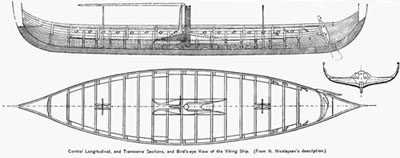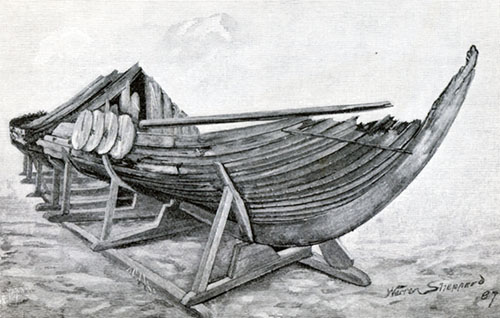The Gokstad Ship
Today, the Gokstad ship. The University of Houston's College of Engineering presents this series about the machines that make our civilization run, and the people whose ingenuity created them.
I'm so far behind in my reading. I've only just finished the 1887 issue of Scribner's Magazine. And an article tells about excavating a 9th-century Viking ship from a burial mound in Gokstad, Norway. The remains of a chieftain were found in the ship. He was six-foot-three, but he suffered from rheumatism before he died.
Later he was found to be Olaf Geirstad-Alf, a minor king in the Yngling Dynasty. Our knowledge of the Ynglings has been historical since Olaf's time. But the old Scandinavian rulers blur into mythology as we continue to move back in time. Many earlier Yngling kings are mentioned in the Beowulf saga.
Today, the Gokstad ship is the best-known of a dozen or so that've been found. And it's the largest of three in Oslo's Viking Ship Museum. Two of those are beautifully-preserved. The Gokstad ship is 78 feet long -- longer than Columbus' flagship, the Santa Maria. The Oseberg Ship is a few decades older and not quite as long as the Gokstad. And both are small in comparison with many of the Viking's great cargo- and people-carrying ships.
Art historian Kenneth Clark forever fixed the Viking Ship in my mind when he described these two ships in his early TV series, Civilisation. He looks at the Gokstad Ship and he says,
... if one wants a symbol of Atlantic man that distinguishes him from Mediterranean man, a symbol to set against the Greek temple, it is the Viking ship. The Greek temple is static and solid. The ship is mobile and light. ... [It] looks as unsinkable as a gigantic water-lily.
Indeed it does. Viewed from the front, its wide hull curves ever-so-gracefully into a small keel. The draft is only a few feet and the ship's thirty-two oarsmen sit low above the water. Like a lily leaf upon the water, they could skim, at nine miles an hour, over vast distances. These are the ships that explored the Northern coast of America. They traded with the Viking community in Greenland for four centuries.
Now this old magazine shows, not the clean oiled-wood hull of the Gokstad ship gleaming in a pristine museum. Instead we see the it emerging from the earthen cocoon that encased it for a millennium. Here, the work of restoring its still-ruined ' hulk is only beginning and we catch a glimpse of the 19th-century imagination awakened to what this once was:

 The carving is meticulously detailed and it covers everything -- all the artifacts of daily life buried with the ship. A carved serpent's mouth swallows the handle of the tiller. The prow, edging, and even planking of the ship -- all engraved. The planks themselves lie upon on another like shingles to keep out the sea.
The carving is meticulously detailed and it covers everything -- all the artifacts of daily life buried with the ship. A carved serpent's mouth swallows the handle of the tiller. The prow, edging, and even planking of the ship -- all engraved. The planks themselves lie upon on another like shingles to keep out the sea.
Here in this old magazine, we just began to understand that the history of the Vikings, like so much of any history, is not to be learned from their sparse documents. Rather it's truly revealed in a peoples' enormously energetic and artistic technology.
I'm John Lienhard, at the University of Houston, where we're interested in the way inventive minds work.
J. S. White, The Viking Ship. Scribner's Magazine, Vol. II, July/Dec. 1887, pp. 604-617. (All images from this source.)
Forer for Vikingskipene (Guide for the Viking Ships) (Oslo: Mittet & Co. A/S -- undated catalog of the Viking Ship Museum).
Sir K., Clark, Civilisation: A Personal View. (New. York: Harper and Row, Publishers, 1969): See Chapt. 1, The Skin of Our Teeth.
For more on the ships, see these sites:
The Wikipedia article on the Gokstad ship
The Wikipedia articleon the Oseberg ship
For more on the Yngling Dynasty, see: https://en.wikipedia.org/wiki/Yngling
For a detailed schematic diagram of the Gokstad, Click on the thumbnail below:


The Prow of the Gokstad, not long after it was first unearthed.

The burial mound from which the Gokstad was taken